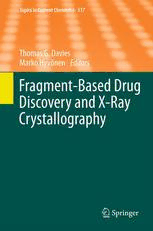
Fragment-Based Drug Discovery and X-Ray Crystallography PDF
Preview Fragment-Based Drug Discovery and X-Ray Crystallography
317 Topics in Current Chemistry Editorial Board: K.N. Houk C.A. Hunter M.J. Krische J.-M. Lehn l l l S.V. Ley M. Olivucci J. Thiem M. Venturi P. Vogel l l l l C.-H. Wong H. Wong H. Yamamoto l l Topics in Current Chemistry Recently Published and Forthcoming Volumes Fragment-BasedDrugDiscoveryandX-Ray FluorousChemistry Crystallography VolumeEditor:Istva´nT.Horva´th VolumeEditors:ThomasG.Davies, Vol.308,2012 MarkoHyvo¨nen MultiscaleMolecularMethodsinApplied Vol.317,2012 Chemistry VolumeEditors:BarbaraKirchner,JadranVrabec NovelSamplingApproachesinHigher Vol.307,2012 DimensionalNMR VolumeEditors:MartinBilleter, SolidStateNMR VladislavOrekhov VolumeEditor:JerryC.C.Chan Vol.316,2012 Vol.306,2012 AdvancedX-RayCrystallography PrionProteins VolumeEditor:KariRissanen VolumeEditor:Jo¨rgTatzelt Vol.315,2012 Vol.305,2011 Microfluidics:TechnologiesandApplications Pyrethroids:FromChrysanthemumtoModern VolumeEditor:BingchengLin IndustrialInsecticide Vol.304,2011 VolumeEditors:NoritadaMatsuo,TatsuyaMori Vol.314,2012 Photocatalysis VolumeEditor:CarloAlbertoBignozzi UnimolecularandSupramolecular Vol.303,2011 ElectronicsII VolumeEditor:RobertM.Metzger ComputationalMechanismsofAuandPt Vol.313,2012 CatalyzedReactions VolumeEditors:ElenaSoriano, UnimolecularandSupramolecular Jose´Marco-Contelles ElectronicsI Vol.302,2011 VolumeEditor:RobertM.Metzger Vol.312,2012 ReactivityTuninginOligosaccharideAssembly VolumeEditors:BertFraser-Reid, Bismuth-MediatedOrganicReactions J.Cristo´balLo´pez VolumeEditor:ThierryOllevier Vol.301,2011 Vol.311,2012 LuminescenceAppliedinSensorScience Peptide-BasedMaterials VolumeEditors:LucaProdi,MarcoMontalti, VolumeEditor:TimothyDeming NelsiZaccheroni Vol.310,2012 Vol.300,2011 AlkaloidSynthesis ChemistryofOpioids VolumeEditor:Hans-JoachimKno¨lker VolumeEditor:HiroshiNagase Vol.309,2012 Vol.299,2011 Fragment-Based Drug Discovery and X-Ray Crystallography Volume Editors: Thomas G. Davies (cid:1) Marko Hyvo¨nen With Contributions by E. Arnold (cid:1) J.D. Bauman (cid:1) P. Brough (cid:1) T.G. Davies (cid:1) H.L. Eaton (cid:1) D.A. Erlanson (cid:1) S. Greive (cid:1) M. Hennig (cid:1) W. Huber (cid:1) R.E. Hubbard (cid:1) M.Hyvo¨nen(cid:1)M.Marsh(cid:1)A.Massey(cid:1)D.Patel(cid:1)A.Ruf(cid:1)D.Rognan(cid:1) S.Roughley(cid:1)T.Sharpe(cid:1)A.W.Stamford(cid:1)C.Strickland(cid:1)I.J.Tickle(cid:1) E.Valkov (cid:1) J.H. Voigt (cid:1) Y.-S.Wang (cid:1) L.Wright(cid:1) D.F. Wyss(cid:1) Z.Zhu Editors Dr.ThomasG.Davies Dr.MarkoHyvo¨nen AstexPharmaceuticals DepartmentofBiochemistry 436CambridgeSciencePark UniversityofCambridge MiltonRoad 80TennisCourtRoad CambridgeCB40QA CambridgeCB21GA UK UK [email protected] [email protected] ISSN0340-1022 e-ISSN1436-5049 ISBN978-3-642-27539-5 e-ISBN978-3-642-27540-1 DOI10.1007/978-3-642-27540-1 SpringerHeidelbergDordrechtLondonNewYork LibraryofCongressControlNumber:2011945781 #Springer-VerlagBerlinHeidelberg2012 Thisworkissubjecttocopyright.Allrightsarereserved,whetherthewholeorpartofthematerialis concerned,specificallytherightsoftranslation,reprinting,reuseofillustrations,recitation,broadcasting, reproductiononmicrofilmorinanyotherway,andstorageindatabanks.Duplicationofthispublication orpartsthereofispermittedonlyundertheprovisionsoftheGermanCopyrightLawofSeptember9, 1965,initscurrentversion,andpermissionforusemustalwaysbeobtainedfromSpringer.Violations areliabletoprosecutionundertheGermanCopyrightLaw. Theuseofgeneraldescriptivenames,registerednames,trademarks,etc.inthispublicationdoesnot imply, even in the absence of a specific statement, that such names are exempt from the relevant protectivelawsandregulationsandthereforefreeforgeneraluse. Printedonacid-freepaper SpringerispartofSpringerScience+BusinessMedia(www.springer.com) Volume Editors Dr.ThomasG.Davies Dr.MarkoHyvo¨nen AstexPharmaceuticals DepartmentofBiochemistry 436CambridgeSciencePark UniversityofCambridge MiltonRoad 80TennisCourtRoad CambridgeCB40QA CambridgeCB21GA UK UK [email protected] [email protected] Editorial Board Prof.Dr.KendallN.Houk Prof.Dr.StevenV.Ley UniversityofCalifornia UniversityChemicalLaboratory DepartmentofChemistryandBiochemistry LensfieldRoad 405HilgardAvenue CambridgeCB21EW LosAngeles,CA90024-1589,USA GreatBritain [email protected] [email protected] Prof.Dr.ChristopherA.Hunter Prof.Dr.MassimoOlivucci DepartmentofChemistry Universita`diSiena UniversityofSheffield DipartimentodiChimica SheffieldS37HF,UnitedKingdom ViaADeGasperi2 c.hunter@sheffield.ac.uk 53100Siena,Italy [email protected] Prof.MichaelJ.Krische Prof.Dr.JoachimThiem UniversityofTexasatAustin Institutfu¨rOrganischeChemie Chemistry&Biochemistry Department Universita¨tHamburg 1UniversityStationA5300 Martin-Luther-King-Platz6 AustinTX,78712-0165,USA 20146Hamburg,Germany [email protected] [email protected] Prof.Dr.Jean-MarieLehn Prof.Dr.MargheritaVenturi ISIS DipartimentodiChimica 8,alle´eGaspardMonge Universita`diBologna BP70028 viaSelmi2 67083StrasbourgCedex,France 40126Bologna,Italy [email protected] [email protected] vi EditorialBoard Prof.Dr.PierreVogel Prof.Dr.HenryWong LaboratoryofGlycochemistry TheChineseUniversityofHongKong andAsymmetricSynthesis UniversityScienceCentre EPFL–Ecolepolytechniquefe´derale DepartmentofChemistry deLausanne Shatin,NewTerritories EPFLSBISICLGSA [email protected] BCH5307(Bat.BCH) 1015Lausanne,Switzerland Prof.Dr.HisashiYamamoto pierre.vogel@epfl.ch ArthurHollyComptonDistinguished Prof.Dr.Chi-HueyWong Professor DepartmentofChemistry Professor of Chemistry, Scripps Research TheUniversityofChicago Institute 5735SouthEllisAvenue PresidentofAcademiaSinica Chicago,IL60637 AcademiaSinica 773-702-5059 128AcademiaRoad USA Section2,Nankang [email protected] Taipei115 Taiwan [email protected] Topics in Current Chemistry Also Available Electronically Topics in Current Chemistry is included in Springer’s eBook package Chemistry andMaterialsScience.Ifalibrarydoesnotoptforthewholepackagethebookseries may be bought on a subscription basis. Also, all back volumes are available electronically. Forallcustomerswithaprintstandingorderweofferfreeaccesstotheelectronic volumesoftheseriespublishedinthecurrentyear. Ifyoudonothaveaccess,youcanstillviewthetableofcontentsofeachvolume and the abstract of each article by going to the SpringerLink homepage, clicking on “Chemistry and Materials Science,” under Subject Collection, then “Book Series,”underContentTypeandfinallybyselectingTopicsinCurrentChemistry. Youwillfindinformationaboutthe –EditorialBoard –AimsandScope –InstructionsforAuthors –SampleContribution atspringer.comusingthesearchfunctionbytypinginTopicsinCurrentChemistry. ColorfiguresarepublishedinfullcolorintheelectronicversiononSpringerLink. Aims and Scope TheseriesTopics inCurrentChemistry presents criticalreviews ofthe present and futuretrendsinmodernchemicalresearch.Thescopeincludesallareasofchemical science,including theinterfaceswithrelated disciplines suchasbiology,medicine, andmaterialsscience. Theobjectiveofeachthematicvolumeistogivethenon-specialistreader,whether at the university or in industry, a comprehensive overview of an area where new insightsofinteresttoalargerscientificaudienceareemerging. vii viii TopicsinCurrentChemistryAlsoAvailableElectronically Thus each review within the volume critically surveys one aspect of that topic and places it within the context of the volume as a whole. The most significant developmentsofthelast5–10yearsarepresented,usingselectedexamplestoillus- trate the principles discussed. A description of the laboratory procedures involved is often useful to the reader. The coverage is not exhaustive in data, but rather conceptual, concentrating on the methodological thinking that will allow the non- specialistreadertounderstandtheinformationpresented. Discussionofpossiblefutureresearchdirectionsintheareaiswelcome. Reviewarticlesfortheindividualvolumesareinvitedbythevolumeeditors. InreferencesTopicsinCurrentChemistryisabbreviatedTop CurrChemandis citedasajournal. ImpactFactor2010:2.067;Section“Chemistry,Multidisciplinary”:Rank44of144 Preface Thefragment-basedapproachhasemergedinthelastdecadeasahighlypromising component of modern drug discovery. Despite its relatively short history, it has beenthesubjectofmanyresearcharticles,reviewsandbooks,andisresponsiblefor several compounds currently in clinical development. Its contribution is increas- ingly recognized by the medicinal chemistry community, and it now forms an importantpartofdrugdiscoveryeffortswithinthepharmaceuticalindustry. Despite the exponential growth of interest in this field, fragment-based drug discovery(FBDD)representsasignificantparadigmshiftfordrugdiscoverers,both philosophically, and in terms of methodology and work-flow. In particular, it has required a shift away from relatively potent, drug-like hits, readily identified by enzymatic high-throughput assays, to the more challenging detection of very weakly (but efficiently) bindingcompounds. As such, the development andappli- cationofrobustandsensitivebiophysicaltechniquestodetectandcharacterisethe bindingofsimple, lowmolecularcompounds has beenakeypartofenablingthis approach.X-raycrystallographywasoneoftheearliesttechniquesdemonstratedto be capable of detecting the binding of fragments, and its additional ability to provide precise three-dimensional detail on their binding modes, and hence guide theirsubsequentelaborationhasledtoitplayingacentralroleinthisapproach. In this volume we bring together chapters by a number of practitioners in the field,drawnfromboththepharmaceuticalindustryandacademia.Ouraimhasbeen to highlight the important roles that X-ray crystallography plays in the fragment- approach: as a sensitive technique for primary screening, its use in combination withotherbiophysicaltechniquestoallowrobusthitvalidation,anditsimportance inprovidingstructuralinformationtoguideprogressionfromhittoclinicalcandi- date. Inthefirstchapter,ErlansonfromCarmotTherapeuticsprovidesanintroduction totheFBDDfieldasawhole,highlightingsomeoftheadvantagesoffragmentsand their means of detection, and giving examples of fragment-derived compounds whichhavealreadyreachedtheclinic.DaviesandTicklefromAstexTherapeutics then provide a review oftheuse ofX-ray crystallography for fragment screening, ix x Preface anddescribesomeofthecomputationaldevelopmentsdevelopedatAstexthathave allowed the rapid generation of protein-ligand structural data required for this approach. In chapter 3, Roughley and colleagues from Vernalis present the first of a number of personal case studies of FBDD – in this case, the application of the fragment-approach to the development of Hsp90 inhibitors, with emphasis on the role of in silico screening, and its interplay with experimental structural informa- tion. This is followed by a chapter from Wyss et al (Merck), who describe their work on the fragment-based development of BACE inhibitors and how comple- mentaryinformationfrombothNMRandX-raycrystallographywerecombinedto successfully prosecute a drug discovery campaign against this important target. Continuingonthethemeofcombiningbiophysicaltechniques,Hennigandcollea- gues then describe the approach to FBDD taken at Roche, and in particular how Surface Plasmon Resonance and structural information are used together in an integratedapproach. Fragment-basedapproachesareincreasinglybeingappliedtochallengingthera- peutic targets, and in particular those for which conventional drug discovery methods have failed. In chapter 6, Valkov and colleagues (University of Cambridge)provideareviewofsmallmoleculeinhibitionofprotein-proteininter- actions,andtheapplicationoffragment-basedmethodsagainstthisclassoftarget. Bauman et al (Rutgers) then describe the use of X-ray crystallographic fragment screeningtoidentifynovelhitsagainstHIVtargets,andhighlightthegrowingtrend foracademic-basedFBDD.Indeed,thecloseassociationofbiophysicalandstruc- tural techniques, combined with the manageable size of screening libraries make fragment-basedmethodsincreasinglyappealingandaccessibletoacademiclabora- toriesinadditiontothoseinthepharmaceuticalindustry. In the concluding chapter, and in a departure from the predominantly experi- mental methods discussed above, Rognan (University of Strasbourg) provides a computational perspective on the fragment-based approach, and discusses the application and development of insilico approaches whichare increasinglybeing appliedinthisarea. Wehopethisbookwillprovideausefulintroductiontosomeofthekeyconcepts and techniques in fragment-based drug discovery, highlighting the diverse set of targets it is applied to, as well as emphasizing the importance of structural infor- mation in this field. The application of X-ray crystallography to structure-based drugdiscoveryisnowamaturediscipline,butonewhosepotentialhassometimes beenunder-exploited.Indrivingvariousaspectsofthefragment-basedapproach,it clearlyplaysacentralrole. Cambridge,January2012 ThomasDavies MarkoHyvo¨nen
